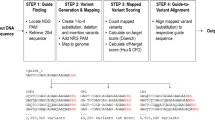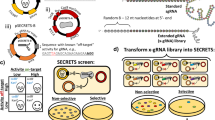Abstract
Selection of guide RNA (gRNA) is important to increase the efficiency of gene editing in the CRISPR/Cas9 system. Due to the variation in actual efficiency of insertion/deletion (indel) mutation among selected gRNAs in silico, reliable methods for validation of efficiency of gRNA need to be developed. Three gRNAs with high on-target scores (72.0 for target 1, 65.4 for target 2, and 62.9 for target 3) were designed to target the quail retinol binding protein 7 (qRbp7) gene, and indel efficiencies were predicted by the Sanger sequencing and Inference of CRISPR Edits (ICE) analysis of sorted cell populations receiving the CRISPR/Cas9 vector. Unlike the order of on-target scores among 3 gRNAs, predicted rates of indel mutations were highest in gRNA2, intermediate in gRNA1, and lowest in gRNA3. This was confirmed by actual indel mutation rates, 51.8% in gRNA2, 31% in gRNA1, and 12.9% in gRNA3, which were calculated by sequencing individual allele cloned into a vector. These data showed a rapid and reliable method for estimation of the efficiency of selected gRNAs, providing a critical necessary step for successful gene editing for further applications.





Similar content being viewed by others
References
Bhaya, D., Davison, M., & Barrangou, R. (2011). CRISPR-Cas systems in bacteria and archaea: Versatile small RNAs for adaptive defense and regulation. Annual Review of Genetics, 45(1), 273–297. https://doi.org/10.1146/annurev-genet-110410-132430.
Wong, N., Liu, W., & Wang, X. (2015). WU-CRISPR: Characteristics of functional guide RNAs for the CRISPR/Cas9 system. Genome Biology, 16(1), 1–8. https://doi.org/10.1186/s13059-015-0784-0.
Tasan, I., & Zhao, H. (2017). Targeting specificity of the CRISPR/Cas9 system. ACS Synthetic Biology, 6(9), 1609–1613. https://doi.org/10.1021/acssynbio.7b00270.
Briner, A. E., Donohoue, P. D., Gomaa, A. A., Selle, K., Slorach, E. M., Nye, C. H., et al. (2014). Guide RNA functional modules direct Cas9 activity and orthogonality. Molecular Cell, 56(2), 333–339. https://doi.org/10.1016/j.molcel.2014.09.019.
Hung, S. S. C., McCaughey, T., Swann, O., Pébay, A., & Hewitt, A. W. (2016). Genome engineering in ophthalmology: Application of CRISPR/Cas to the treatment of eye disease. Progress in Retinal and Eye Research. https://doi.org/10.1016/j.preteyeres.2016.05.001.
Horlbeck, M. A., Witkowsky, L. B., Guglielmi, B., Replogle, J. M., Gilbert, L. A., Villalta, J. E., et al. (2016). Nucleosomes impede cas9 access to DNA in vivo and in vitro. eLife. https://doi.org/10.7554/eLife.12677.
Doench, J. G., Fusi, N., Sullender, M., Hegde, M., Vaimberg, E. W., Donovan, K. F., et al. (2016). Optimized sgRNA design to maximize activity and minimize off-target effects of CRISPR-Cas9. Nature Biotechnology, 34(2), 184–191. https://doi.org/10.1038/nbt.3437.
Lee, J., Ma, J., & Lee, K. (2019). Direct delivery of adenoviral CRISPR/Cas9 vector into the blastoderm for generation of targeted gene knockout in quail. Proceedings of the National Academy of Sciences of the United States of America, 116(27), 13288–13292. https://doi.org/10.1073/pnas.1903230116.
Lee, J., Kim, D. H., & Lee, K. (2020). Muscle hyperplasia in Japanese quail by single amino acid deletion in MSTN propeptide. International Journal of Molecular Sciences, 21(4), 1504. https://doi.org/10.3390/ijms21041504.
Ahn, J., Lee, J., Park, J. Y., Oh, K. B., Hwang, S., Lee, C. W., et al. (2017). Targeted genome editing in a quail cell line using a customized CRISPR/Cas9 system. Poultry Science, 96(5), 1445–1450. https://doi.org/10.3382/ps/pew435.
Hsiau, T., Maures, T., Waite, K., Yang, J., Kelso, R., Holden, K., et al. (2018). Inference of CRISPR edits from sanger trace data. bioRxiv. https://doi.org/10.1101/251082.
Roelz, R., Pilz, I. H., Mutschler, M., & Pahl, H. L. (2010). Of mice and men: Human RNA polymerase III promoter U6 is more efficient than its murine homologue for shRNA expression from a lentiviral vector in both human and murine progenitor cells. Experimental Hematology, 38(9), 792–797. https://doi.org/10.1016/j.exphem.2010.05.005.
Bannister, S. C., Wise, T. G., Cahill, D. M., & Doran, T. J. (2007). Comparison of chicken 7SK and U6 RNA polymerase III promoters for short hairpin RNA expression. BMC Biotechnology. https://doi.org/10.1186/1472-6750-7-79.
Jiang, F., & Doudna, J. A. (2017). CRISPR–Cas9 structures and mechanisms. Annual Review of Biophysics, 46(1), 505–529. https://doi.org/10.1146/annurev-biophys-062215-010822.
Wang, J., Wang, H., Liu, S., Liu, L., Tay, W. T., Walsh, T. K., et al. (2017). CRISPR/Cas9 mediated genome editing of Helicoverpa armigera with mutations of an ABC transporter gene HaABCA2 confers resistance to Bacillus thuringiensis Cry2A toxins. Insect Biochemistry and Molecular Biology, 87, 147–153. https://doi.org/10.1016/j.ibmb.2017.07.002.
Stukenberg, D., Zauner, S., Dell’Aquila, G., & Maier, U. G. (2018). Optimizing CRISPR/cas9 for the diatom Phaeodactylum tricornutum. Frontiers in Plant Science. https://doi.org/10.3389/fpls.2018.00740.
Chang, C. T., Tsai, C. L. N. L., Tang, C. Y., Chen, C. H., Lian, J. H., Hu, C. Y., et al. (2012). Mixed sequence reader: A program for analyzing DNA sequences with heterozygous base calling. The Scientific World Journal, 2012, 365104. https://doi.org/10.1100/2012/365104.
Cong, L., Ran, F. A., Cox, D., Lin, S., Barretto, R., Habib, N., et al. (2013). Multiplex genome engineering using CRISPR/Cas systems. Science, 339(6121), 819–823. https://doi.org/10.1126/science.1231143.
Kim, G., Lee, J. H., Song, S., Kim, S. W., Han, J. S., Shin, S. P., et al. (2020). Generation of myostatin-knockout chickens mediated by D10A-Cas9 nickase. The FASEB Journal. https://doi.org/10.1096/fj.201903035R.
Kim, S. W., Lee, J. H., Park, B. C., & Park, T. S. (2017). Myotube differentiation in clustered regularly interspaced short palindromic repeat/Cas9-mediated MyoD knockout quail myoblast cells. Asian-Australasian Journal of Animal Sciences, 30(7), 1029–1036. https://doi.org/10.5713/ajas.16.0749.
Yang, Z., Steentoft, C., Hauge, C., Hansen, L., Thomsen, A. L., Niola, F., et al. (2015). Fast and sensitive detection of indels induced by precise gene targeting. Nucleic Acids Research. https://doi.org/10.1093/nar/gkv126.
Überbacher, C., Obergasteiger, J., Volta, M., Venezia, S., Müller, S., Pesce, I., et al. (2019). Application of CRISPR/Cas9 editing and digital droplet PCR in human iPSCs to generate novel knock-in reporter lines to visualize dopaminergic neurons. Stem Cell Research. https://doi.org/10.1016/j.scr.2019.101656.
Wienert, B., Wyman, S. K., Richardson, C. D., Yeh, C. D., Akcakaya, P., Porritt, M. J., et al. (2019). Unbiased detection of CRISPR off-targets in vivo using DISCOVER-Seq. Science. https://doi.org/10.1126/science.aav9023.
Haeussler, M., Schönig, K., Eckert, H., Eschstruth, A., Mianné, J., Renaud, J. B., et al. (2016). Evaluation of off-target and on-target scoring algorithms and integration into the guide RNA selection tool CRISPOR. Genome Biology, 17(1), 1–12. https://doi.org/10.1186/s13059-016-1012-2.
Liang, G., Zhang, H., Lou, D., & Yu, D. (2016). Selection of highly efficient sgRNAs for CRISPR/Cas9-based plant genome editing. Scientific Reports, 6, 1–8. https://doi.org/10.1038/srep21451.
Funding
This research was funded by the United States Department of Agriculture National Institute of Food and Agriculture Grant (Award No. 2020-67015-31537).
Author information
Authors and Affiliations
Contributions
All authors contributed to the study conception and design. Material preparation, data collection and analysis were performed by D-HK, JL, and YS. The first draft of the manuscript was written by D-HK, JL, and KL and all authors commented on previous versions of the manuscript. All authors read and approved the final manuscript.
Corresponding author
Ethics declarations
Conflict of interest
The authors declare that they have no competing interest.
Additional information
Publisher's Note
Springer Nature remains neutral with regard to jurisdictional claims in published maps and institutional affiliations.
Supplementary information
Below is the link to the electronic supplementary material.
Rights and permissions
About this article
Cite this article
Kim, DH., Lee, J., Suh, Y. et al. Necessity for Validation of Effectiveness of Selected Guide RNA In Silico for Application of CRISPR/Cas9. Mol Biotechnol 63, 140–149 (2021). https://doi.org/10.1007/s12033-020-00290-8
Accepted:
Published:
Issue Date:
DOI: https://doi.org/10.1007/s12033-020-00290-8




